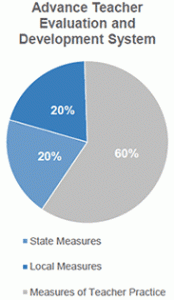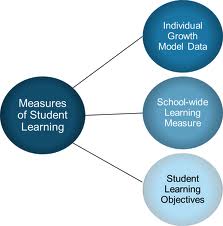This past week my public elementary school, like many others throughout NYC, administered Measures of Student Learning (MOSL) Performance Assessments in English-language arts (ELA) and math to students in grades K-5.
WHY? NYC teachers have a new teacher evaluation and development system called Advance. 20% of our overall teacher effectiveness rating comes from a local measure of student learning or MOSL (another 20% of our rating is based on a state measure such as the NYS CCSS ELA and math assessments). Here is the NYC DOE’s definition of “local measure”:
- Local Measure – Recommended by a school committee appointed by the principal and UFT Chapter Chair and approved by the principal*, each teacher’s local measure will be based on student growth on assessments and growth measures selected from a menu of approved options for each grade and subject (from the NYC DOE website).
My school chose the new K-5 NYC Performance Assessments in ELA and math as our local measure. The recently administered September Performance Assessments will be used to establish baseline scores for our students who will be assessed again at the end of the school year to determine their growth in these two subject areas. As per MOSL, students’ growth on this task – or lack of – contributes to 20% of our overall teacher effectiveness rating.
It is important to note that the local measure (MOSL) is separate from the state measure, which also counts towards 20% of our overall rating. This means that in the spring of 2014, our students in grades 3-5 will have to take these new NYC ELA and math Performance Assessments IN ADDITION TO the controversial state CCSS ELA and math exams (state measure). I am not taking into consideration teacher-generated tests based on content learned in the classroom.
WHAT are the NYC Performance Assessments? This past week, I helped administer the ELA NYC Performance Assessment to the ELLs (English-language learners) that I service. The first grade ELA Performance Assessment was particularly disturbing and anguishing to administer, so much so that I tossed and turned all last night. Here’s why:
1.) The NYC DOE recommended length of the task was 85-120 minutes over two consecutive days (remember: THIS IS FIRST GRADE!)
2.) After the teacher modeled the task, students had to independently read a non-fiction text that was different from the one the teacher used to model. The title that was pre-selected (not by teachers) for our first graders to read independently was Sea Turtles by Carol K. Lindeen. The age range for this title is preschool – 8, however I believe that for the younger kids, this book is meant to be used as a read aloud and/or for pleasure reading, NOT for use as an assessment. Sea Turtles, which our beginner first grade ELLs were required to read independently, is a level J book, according to Fountas & Pinnell.
3.) The assessment script instructed teachers to encourage first graders to take notes – in their own words – while independently reading Sea Turtles. Note-taking was modeled to the students prior to the start of the assessment. By note-taking, students were instructed to generate two text-based questions while independently reading Sea Turtles. They then had to use the text to answer the questions that they came up with on their own while independently reading a level J non-fiction book. In case you missed it the first time, I reiterate that these are new FIRST GRADERS.
4.) On day two, our first grade students used their notes (student-generated questions and answers) to write their own informational text about sea turtles. They were required to name the topic, include facts and vocabulary words from the text (perhaps migrate or mate?), use writing conventions and write a one sentence conclusion.
To satisfy my Danielson requirement – the remaining 60% of my effectiveness rating as per the new NYC teacher evaluation and development system – here are my reflections/wonderings (Danielson 4a) on the ELA NYC Performance Assessments:
1.) What’s the point of report cards and teacher-generated assessments based on content taught in the classroom if our students’ academic worth is now determined by these official state and local measures? We are teaching to the test more than ever, particularly in schools in low-income areas (Title I schools) where students have more catching up to do and where test scores are lower. If test scores remain low for too long, a school becomes at-risk for closure.
2.) Our rating for this part of the NYC teacher evaluation plan is based on student growth. Low scores on the September assessments are actually advantageous to teachers as students will very likely score higher (showing growth) on the June assessment. Also, these are not teacher-generated assessments. For the ELA Performance Assessment, first grade teachers were handed a five-page assessment script and materials and were told to administer it. This, to me, is a farce. I am hard-pressed to find any meaning in these non-teacher created assessments that test students on skills they do not yet possess. They are a burden to students, teachers and administrators as well as a waste of time and money. I’m not even describing here the resources and time spent on scoring the assessments. The scores will be entered into a database for tracking purposes.
3.) How can anyone still believe that the Common Core State Standards (CCSS) stand alone and can be separated from standardized testing, curriculum and teacher evaluations?
4.) In NYS, teachers are losing their freedom to teach and students are being deprived of their freedom to learn. These NYC Performance Assessments are the latest example. As I have noted previous posts, choice is an illusion.
5.) How can seemingly intelligent Tweed decision-makers like Dennis Walcott and Shael Polakow-Suransky truly believe that these Performance Assessments are of any value? I want them to explain to us why they believe in these particular assessments. Beth Fertig, WNYC education reporter, recently tweeted that “Walcott says he’s not serving the mayor but students: “I’m a true believer in what we’re doing.”
6.) What is the true purpose of these Performance Assessments? To measure student growth or to hold accountable teachers who either aren’t in a testing grade (K-2) or who teach a subject that’s not formally assessed by the state (music and art, for example)?
6.) Isn’t elementary school supposed to be fun, meaningful and engaging? Teachers, students and administrators should not have to suffer like this.
These are our students. This is Race to the Top and Common Core. These are our students under the influence of Race to the Top and Common Core. Any questions?



Very well said. Giving that assessment to 5 and 6 year olds was very unfair to them. We want to give children the feeling of accomplishment, not failure.
Lori, you hit the nail in the head. Little ones need to relish in accomplishments to encourage them to try to reach the next goal. Failure after failure is what breeds learn ed helplessness and discourages further trying.
Pingback: Make Them Stop, Make Them Go Away, Leave the Children Alone! | Diane Ravitch's blog
Pingback: Remainders: Amplify pilot suspended after hardware meltdown | GothamSchools
The subheading of your blog says it all. Thank you for challenging the forces (like these tests) that are taking creativity and inspiration out of all of our classrooms, at all levels.
Pingback: Dear Carmen Fariña: NYC Schools Need Joy and Democracy | Critical Classrooms, Critical Kids
Pingback: Carmen Fariña’s Visit to District 19: A Call to Boycott Pearson Field Testing | Critical Classrooms, Critical Kids
May not come home when wanted, remaining out all night.
Addiction has forcefully adverse effects on adolescents, their families as well as the recognition of these expectations and dreams.
Learn Psychology absolutely online in a situation-of-the-craft online class given by the
NACE.
Pingback: What’s REALLY Rotten in Our Schools: Poor Quality MOSL Assessments Used to Rate NYC Teachers | Critical Classrooms, Critical Kids